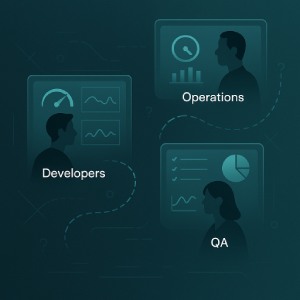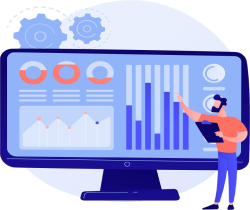The Role of Real-Time Analytics in Building Collaboration
The days of having one person stay independent on several tasks are over. Various companies are now embracing the use of real-time analytics as a reliable way to get immediate insights into system performance.
There’s no need to wait for after-action reports or static logs. Dev, Ops, and QA teams can now see issues as they occur. It is this shared access that helps reduce the delays that often result from hand-offs or siloed tools.
When all three teams use the same analytics dashboard, it becomes possible to view live application data, latency spikes, and reliability trends all at the same time.
The Challenge of Disconnected Teams

For years, development pipelines suffered from teams speaking different “data languages.” This was because each section had different independent areas of concentration. As a result:
- Developers cared about speed and functionality.
- Operations focused on uptime, server load and incident response.
- QA only prioritized test results and defect tracking.
As you can see, each team measured success differently, which meant collaboration often broke down when issues arose. Without a single, verified source of reliable fact and data, discussions about performance or stability became debates instead of problem-solving sessions. When problems occurred in production, blame often followed because there wasn’t any collective understanding of the data.
A system without common metrics makes it nearly impossible to pinpoint what went wrong quickly. Developers might insist “it works on my machine,” Ops might blame the deployment pipeline, and QA might struggle to reproduce the issue.
Emphasis on Better Communication and Responsibility
Data-driven collaboration shifts the culture from reactive to proactive. When all teams have continuous visibility into performance, they react to these issues and prevent them. This way:
- Developers can test with live data to anticipate how changes affect production.
- Ops teams have better preparations for scaling needs before traffic surges happen.
- QA can validate fixes faster which reduces feedback cycles.
The most powerful outcome is shared responsibility. No single team owns success or failure. Whichever way you look at it, everyone contributes to maintaining performance and reliability one way or the other.
How to Turn Insights into Action
Data is only valuable when it drives decisions. After analytics are integrated into DevOps pipelines, the next step is learning how to turn those insights into immediate, measurable action. Here’s the best way to achieve this:
Integrating Analytics into DevOps Pipelines
When integrated directly into CI/CD pipelines, analytics turn every deployment into a feedback opportunity. It’s a procedure that allows everyone to work as a collective unit.
That way, developers can instantly evaluate performance impacts while QA can adjust test coverage dynamically, and then Ops can focus on monitoring how new builds affect stability.
IBM’s 2024 DevOps Report shows that teams using analytics-driven pipelines achieved 50% faster deployment cycles and incident resolution. In this model, data serves as a continuous learning loop, ensuring that every iteration brings measurable improvements to system performance and reliability.
Key Metrics That Unite Teams
The only way shared analytics can work effectively is when the right data points are measured. For this to happen, the goal is to track metrics that matter equally to Dev, Ops and QA.
Some essential ones include:
- Application uptime and latency: Direct indicators of user experience and system reliability.
- Error and failure rates: Reveal issues in deployment, code stability and testing accuracy.
- Build and deployment success rates: Show pipeline reliability and pinpoint the recurring failure areas.
- Test coverage and regression counts: Assists QA and Dev monitor quality trends.
- Resource utilization: Allow Ops to forecast scaling and infrastructure needs.
When these metrics are in one place, teams have a balanced view of both performance and reliability. That way, it becomes easy to measure success not just by how quickly code ships, but by how well it runs in production.
Tools That Enable Unified Collaboration
Modern DevOps ecosystems work best on integration. Tools that promote visibility and collaboration are usually what drive this change. Here are some of the top tools that encourage efficiency in this aspect:
- CI/CD platforms: Jenkins, GitHub Actions, and GitLab CI help automate testing and deployment, ensuring every change is tracked.
- Monitoring systems: Prometheus, New Relic, and Datadog provide instant feedback on system health and performance.
- Communication tools: Includes Slack and Microsoft Teams that integrate with analytics dashboards to push live alerts.
- Issue tracking systems: Tools like Jira connect performance metrics with better insights that help connect problems to specific builds or commits.
When these tools feed into a unified analytics layer, teams stop working in isolation. Each release becomes a shared milestone, supported by real-time validation and clear data communication.
How Real-Time Analytics Bridges the Gap

With analytics platforms like Grafana, Datadog, or New Relic, performance data is no longer owned by one team. Everyone can track response times, error rates, test coverage, and deployment status simultaneously. This single view means no one waits for updates or explanations since the data itself tells the story.
That said, using real-time analytics bridges gaps in three main ways:
- Transparency: Everyone has access to the same metrics, reducing confusion and misinterpretation.
- Speed: When something breaks, teams identify the source faster because they see the same data streams.
- Accountability: Shared dashboards foster a culture of joint responsibility instead of finger-pointing.
Key Takeaway
Real-time analytics has redefined how modern software teams work together. It replaces silos with transparency, replaces assumptions with data, and replaces blame with shared responsibility.
When Dev, Ops and QA operate from a single source of truth, collaboration stops being a challenge and becomes second nature. Everyone sees the same story unfold, speaks the same language of performance, and shares the same goal of achieving reliability.